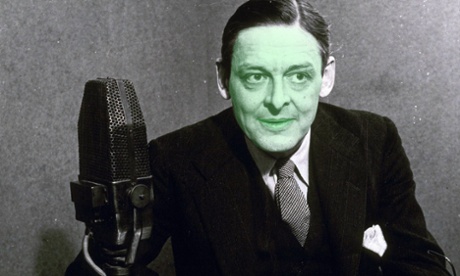
When writing, I like to pace back and forth across a room. Usually I don’t even realise I’m doing it until I collide with an inanimate object or an unfortunate passerby. Apparently I’m in good company: Charles Dickens, William Wordsworth and Virginia Woolf all paced while writing, while Philip Roth has said he walks “half a mile for every page”.
While we all have our little quirks, some are definitely more bizarre than others. From painting their face green to always writing drunk, here are five of the most peculiar writing habits.
TS Eliot wore green makeup and lipstick when he wrote
After writing The Waste Land, TS Eliot took to wearing green-tinted face powder and lipstick – and his strange complexion did not go unnoticed. In the early 20s, Osbert Sitwell said Eliot’s face was “pale but distinctly green … the colour of forced lily-of-the-valley.” Likewise, while writing in her diary on 12 March 1922, Virginia Woolf remarked: “I am not sure that he does not paint his lips.”
Quite why he assumed a green pallor, nobody knew. But there were rumours. While talking to Woolf’s sister Vanessa, Clive Bell said he thought Eliot powdered his face in order to look “interesting and cadaverous”.
His biographer, Peter Ackroyd, agreed: “Eliot felt wearing face powder made him look more modern, more interesting, a poet rather than a bank official.”
Edgar Allan Poe would only write on strips of paper
Another author with a peculiar writing habit was Edgar Allan Poe, who would only write on long, narrow sheets of parchment, which he sealed together with wax. Poe would then roll up these manuscripts like scrolls to store in his writing desk.
“He made quite a scroll and [it] must have taken him a long time to write out,” wrote Miss Susan Ingram in 1849, to whom Poe gifted a handwritten copy of Ulalume weeks before his death. “The 10 stanzas were written on five sheets of paper pasted together in the neatest possible way, end to end.”
Similarly, Frances Osgood recalls Poe showing her the manuscript of The Literati, which was so long that, once unfurled, it stretched all the way across the room. The reasons for this writing habit is unknown, but biographer Kevin Hayes suggests Poe liked the flow of the scroll. “He recognised a relationship between the physical process of writing and the final literary product … the written scroll lent continuity to a work that individual sheets could not replicate.”
F Scott Fitzgerald always wrote drunk
There has been much debate on the effect of alcohol on creativity. While poet Xiuxi Yin claimed “once drunk, a cup of wine can bring 100 stanzas”, Martin Amis said: “The author who writes his books on whisky is a lousy writer.” Perhaps the most notorious of all literary tipplers is the writer who once said: “Too much of anything is bad, but too much champagne is just right” – F Scott Fitzgerald.
Fitzgerald maintained that alcohol helped him to write: “Two years ago I noticed that when I stopped all drinking for three weeks or so, I immediately had dark circles under my eyes, was listless and disinclined to work,” he wrote to his wife Zelda in the 30s.
However, even he knew the shortcomings of writing while drunk. “A short story can be written on a bottle,” Fitzgerald told his editor Maxwell Perkins, “but for a novel you need the mental speed that enables you to keep the whole pattern in your head and ruthlessly sacrifice the sideshows.”
Unfortunately things didn’t end well for Fitzgerald, as what started out as a habit led to a full-blown addiction, which probably contributed to the fatal heart attack he had in his early forties.
Ernest Hemingway wrote standing up
Though once a close drinking companion of Fitzgerald, Hemingway always wrote sober. His particular peculiarity was due to a minor leg injury sustained in the first world war, which meant he found it more comfortable to write standing up than sitting down.
“[It’s] a working habit he has had from the beginning,” wrote George Plimpton in an interview with the author in 1954. “He stands in a pair of his oversized loafers on the worn skin of a lesser kudu – with the typewriter and the reading board chest-high opposite him.”
Hemingway wasn’t the only one: Lewis Carroll and Thomas Wolfe also chose to stand up while they worked. In fact, standing while working has been shown to increase productivity, with the latest research from Public Health England suggesting we should all be on our feet for at least four hours every working day. So perhaps Hemingway was simply ahead of the game.
George Bernard Shaw wrote in a revolving shed
Shaw constructed a unique invention “the revolving writing hut” which was mounted on a circular mechanism – allowing him to follow the sun throughout the day as he worked.
The shed also afforded Shaw privacy while writing. “People bother me,” Shaw said. “I come here to hide from them.” Quite. And while hidden in his shed, Shaw wrote some of his best-known works, including Pygmalion and Androcles and the Lion.
So, perhaps you also apply green powder, roll up scrolls or retire to write in your revolving shed. Or possibly you have other writing oddities you’d like to share? Let us know in the comments below.

